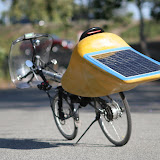Part one will focus on what it means when a solar panel manufacturer labels a panel as being "50 watts" and why you will not get 50 watts of power out of such a panel under most real world conditions. I will use an actual 50 watt panel mounted on an actual bike to show why it was only producing 21.5 watts at 2 PM on February 1st in Northern California.
When a manufacturer indicates that a panel has a "nameplate", "rated", "nominal" or "maximum" power output of 50 watts, they're talking about a measurement taken at STC or Standard Test Conditions. This means an irradiance of 1000 watt per square meter (very bright sun at noon) and a PV cell temperature of 25°C (77°F). These conditions are used not because they are representative of typical real-world conditions under which the solar panel will be used but because they are practical for testing panels coming off a high speed assembly line in a factory. The panels are very briefly exposed to artificial sunlight ("flashed") and if they are within the expected power tolerance (+/-5% for my panel) they are labeled as 50W.
 |
| Daystar irradiance meter measures watts/m² |
The 25°C cell temperature is a little trickier to understand. A solar panel exposed to 1000 watts per square meter of solar irradiance is going to be heated approximately 25°C above ambient air temperature because it is a dark surface and most of the absorbed energy is converted to heat. In order to achieve 25°C cell temperature, the external air temperature would have to be around 0°C (32°F). In the real world, your panel is going to be warmer than 25°C when the sun is at its brightest. Although it may seem counter-intuitive, most solar cells lose about 0.5% of their rated power for each degree centigrade above 25. On a hot summer day, this is typically a 10-15% loss relative to STC.
Solar irradiance determines how much current the panel generates (amps). Cell temperature determines the voltage. Power is measured in watts, which are simply amps times volts. Reducing either amps or volts results in reduced power.
 |
| Infrared thermometer to measure solar cell temperature |
I then measured the cell temperature using an infrared thermometer and recorded an average temperature of 20.3°C (68.5°F). Since this is lower than the 25°C STC temperature, the temperature correction for power output will result in a slight power increase relative to STC. The temperature coefficient of power for most SunPower panels is -0.38%/C, this is a 1.8% increase in power ((20.3-25)*-0.0038).
The expected power output under these conditions is 22.8 watts (50W STC * 0.448 irradiance correction * 1.018 temperature correction). The actual power reading measured between the charge controller and the battery under these conditions was 21.5 watts. The additional 6% loss can be explained by expected system losses due to wiring voltage drop and charge controller efficiency.
These real-world conditions are constantly changing and they don't answer the question that everyone with an electric bike really wants to know the answer to:
How many extra miles can I get from my battery if I mount a solar panel on my bike?To answer this question, we need to take average weather conditions into account and add up all the hours of daylight in a typical month in a typical meteorological year. I will explain how to do that in part two of this series. Don't worry, it's easier than it sounds and you won't need any fancy measuring tools.
 |
| "Watts Up" watt-hour meter measures output from charge controller into 48V Li-ion battery |




1 comment:
Hello,
what kind of electric engine?
how did you solved it?
best,
Máté
Post a Comment